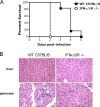MDA5 and MAVS mediate type I interferon responses to coxsackie B virus
- PMID: 19846534
- PMCID: PMC2798442
- DOI: 10.1128/JVI.00631-09
MDA5 and MAVS mediate type I interferon responses to coxsackie B virus
Abstract
Coxsackie B viruses (CVB) are enteroviruses that have been associated with a variety of human diseases, including myocarditis. In the present study, we found that MDA5 and its adaptor molecule MAVS are critical for type I interferon responses to CVB, since the absence of either MAVS or MDA5 leads to deficient type I interferon production and early mortality in mice infected with CVB. Pancreatic and hepatic necrosis were observed on histopathological examination of MAVS and MDA5 knockout mice infected with CVB. Inflammatory cytokine production in response to systemic CVB infection was independent of MAVS. Surprisingly, virus titers were not elevated in MAVS-deficient mice, despite significant reductions in type I interferon levels. These data highlight the importance of type I interferon in host defense and provide insight on the mechanisms of innate immune responses following coxsackievirus infection.
Figures






References
-
- Adachi, O., T. Kawai, K. Takeda, M. Matsumoto, H. Tsutsui, M. Sakagami, K. Nakanishi, and S. Akira. 1998. Targeted disruption of the MyD88 gene results in loss of IL-1- and IL-18-mediated function. Immunity 9:143-150. - PubMed
-
- Alexopoulou, L., A. C. Holt, R. Medzhitov, and R. A. Flavell. 2001. Recognition of double-stranded RNA and activation of NF-κB by Toll-like receptor 3. Nature 413:732-738. - PubMed
-
- Bergelson, J. M., J. A. Cunningham, G. Droguett, E. A. Kurt-Jones, A. Krithivas, J. S. Hong, M. S. Horwitz, R. L. Crowell, and R. W. Finberg. 1997. Isolation of a common receptor for Coxsackie B viruses and adenoviruses 2 and 5. Science 275:1320-1323. - PubMed
Publication types
MeSH terms
Substances
Grants and funding
LinkOut - more resources
Full Text Sources
Other Literature Sources
Miscellaneous

